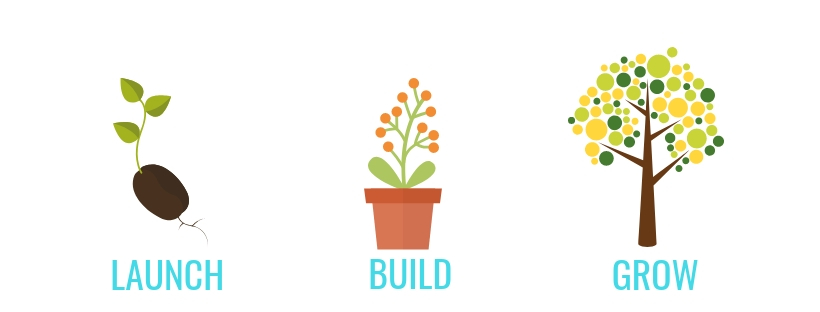LISTEN TO AUDIO VERSION
READ AS AN ARTICLE
Have you ever felt so busy that you can’t keep up writing content for your blog? I’ll share with you some practical goal setting hacks I follow and hope that they will be of help to you, too!
If blogging is your full-time income source, you may have started your own rhythm in creating and publishing posts. Content planning is a no-brainer to you. And you already know how to measure your results.
But if you’re a blogger who does this as a side-hustle or hobby, setting smart goals is something you may have already forgotten. You prefer writing spontaneously, whenever you’re smitten by inspiration.
However, you find yourself all over the place, disorganized and going nowhere.
This is how blogging was for me for five years since I started in 2011. I had no plans. I just knew I’d love to write (and I can be an article-writing machine). Until I realized that publishing posts on my website take time, energy, and money.
- You would spend on transportation when covering corporate events.
- You have to look presentable so you’d want to get a wardrobe, or even your hair and makeup done.
- You want to share the most attractive photos so you’ll make time for DIY photo shoots.
- You would skip your weekend rest just to catch up with your article backlogs.
Despite all the preparations, I had no idea of how to earn from my blog and recover my expenses. When reality hit me, I just decided to use it as a portfolio to show off my writing skills to potential clients as a freelance writer.

Years later, I shifted from freelancing into business. I had a change in perspective.
Since I’m not getting any younger (and would soon want to have a family), I don’t have all the time in the world to write without making money out of it.
I strategize on how writing each content to serve me in the long-run than a simple past-time activity. My blog is not an end-goal, rather a tool to attract potential clients for my information products and courses.
Why should you start with a goal, too?
I would like to emphasize since the idea is really valuable. You’ll be able to save three important resources in your life when you set smart goals for your blog:
- Time – Honestly, how much time are you willing to spend in a day or week to write and create content?
- Money – Have you thought about the costs of running a blog? Are you using a free platform? If you’re on paid hosting and domain, how much annual costs are you expecting?
- Energy – Blogging requires several other activities aside from writing. That could include shooting photos, image editing, social media handling, joining events, etc. Are you focusing your energy in areas that give you results?
If you think you can’t answer one of these three questions or certainly admit you need help. Read on.

Remember this quote from Brian Tracy if you need the motivation to start planning.
“Goal-setting will do more to help you achieve the things you want in life than will anything else you’ve been exposed to. Becoming an expert at goal-setting and goal-achieving is something that you absolutely must do if you wish to fulfill your potential as a human being.”
Now that’s a life hack!
Smart Goal Setting Hacks for Bloggers
A simple approach to set goals is to answer the 5Ws and 1H questions. I also use this technique whenever I want to get over writer’s block.
- What do I want to accomplish?
- Why is this goal important?
- Who are my readers? Who will be involved in the content creation process?
- Where will I get the resources I need? Where will I promote?
- When will I execute?
- How am I going to achieve my targets?
Alternately, you can also go through an in-depth goal setting activity using the SMART framework.
Don’t start to blog without a SMART plan.
S.M.A.R.T. stands for specific, measurable, achievable, relevant, and time-bound.
- Specific (simple, sensible, significant).
- Measurable (meaningful, motivating).
- Achievable (agreed, attainable).
- Relevant (reasonable, realistic and resourced, results-based).
- Time bound (time-based, time-limited, time/cost limited, timely, time-sensitive).
The acronym was first written by George T. Doran in November 1981 in Spokane, Washington in a paper “There’s a S.M.A.R.T. Way to Write Management’s Goals and Objectives”. It was also attributed by Peter Drucker’s Management by Objectives.
Let’s apply the SMART goal framework for your blog.
S.M.A.R.T. Goal Checklist #1: Set Specific Goals
Step back and assess your current situation if you want to create concrete goals for your blog. Which of these three stages are you in?

Launch Phase
If it’s the first year of your blog and you haven’t started yet, your specific goals should be aligned on this stage. Read our blog post, “How to Start A Blog for Your Business”.
Warning: Seasoned bloggers or entrepreneurs would usually refer to the starting phase as “the poop phase”. Expect to work insanely hard in the beginning while feeling that you’re not getting anywhere.
But don’t be discouraged. You’re only building your skills, especially if blogging is new for you. You’ll strengthen this as you learn the ropes.
Build Phase
You’re now familiar with the blog content creation process from planning posts, writing, publishing, and promoting. Bloggers on the build stage usually aim for ways to get engagement and conversion results. We’ll learn about these two in the next step.
Warning: The Build Phase is a roller-coaster ride. When you start to get real income from blogging, you’ll foolishly think you’ve figured it out.
- You’ll earn cash or get event invitations in a month. And earn zero on the next.
- You’ll have one post that goes viral. The next day you’ll get spam alerts and tech glitches.
- You’ll get featured in an online magazine. But you don’t know how to make the most out of your new traffic.
One specific goal that I’ll recommend for bloggers in the build phase is to learn to create a system for effective writing. Maintaining a blog is not just about creativity. You need to plan out your processes, too.
Growth Phase
Being in the growth phase when it comes to blogging mean that you’ve already gained the skills you need to move your business forward.
Yes, I mentioned “business” because this is not just a hobby to you. You’ve seen its potential to grow. You’re thinking of how to increase your income and followers.
In this stage, you already know how to write blog posts faster. Your headline ideas are a magnet. You’re now hands-on with tech. You’ve gained clients and have customer service solutions in place.
Here are some sample goals depending on the phase you’re in.
- Launch my blog in March 2019.
- Build my e-mail list.
- Grow my blog traffic and income.
Here are specific versions of the statements:
- Launch my marketing niche blog “pinoymarketinginsights.com” in March 2019.
- Build my business by creating and promoting a lead magnet that will attract at least 500 e-mail subscribers among blog readers.
- Grow my blog traffic by 100% this year resulting to
20 % increase in annual income.
S.M.A.R.T. Goal Checklist #2: Set Measurable Results
Setting smart goals for your blog means that you know how to measure the results you want to achieve.
Generally, the three areas we’re looking at in most online marketing activities including blogging are these three:
- Reach
- Engagement
- Converstions
1. Measuring Your Blog Reach
How many blog views would you like to have
To make it less complicated, you can monitor your most-read posts every six months.
If your specific goal is to improve the quality of the content you create to get more readers or to apply SEO techniques for your blog, then measure your reach. This also speaks about your potential audience size.
2. Measuring Your Blog Engagement
Which posts has the most comment or share? Did you get more blog likes when you started sharing your articles in Facebook groups? Are people subscribing?
Twitter retweets (RTs) and Facebook shares will help you find out who is spreading your content. This will also help you gain reader insights so you can plan engaging content.
3. Measuring Your Blog Conversion
There are two simple ways to convert readers to customers:
- Create links from your blog post directing them to a sales page.
- Capture your reader’s email address and sending them an offer.
Your sales page/ landing page allows you to access a summary report to see how many conversions came from your blog visitors. Your chosen email autoresponder also does this for you.
S.M.A.R.T. Goal Checklist #3: Create Achievable Goals
Is your goal realistic? Or is it an overwhelming, blown up target from your imagination?
If you’ll say “I want to earn one million pesos from my blog this year!”, but you only have 100 followers, that’s too ambitious.
It’s good to challenge yourself but make sure…
- You know what it takes to reach the goal.
- You have the capacity to apply what you know and reach the goal.
- You can sustain your systems and processes when you get there.
For example, if you identified that raising one million pesos is possible by selling a Php10,000 course to one hundred people through blogging and other marketing efforts, do you have a quality product and efficient backend customer service support?
Our smart blog planning worksheet will ask you to list down the inputs or steps you need to make in order to achieve your goals.

S.M.A.R.T. Goal Checklist #4: Relevance
There is a two-sided approach to check if your goals are relevant. Find out why is it important to you and your target customers.
Are your goals relevant to your current lifestyle?
Maybe you want to have online followers or income to go through a transition period in your life. You’re a new mom and you want to pursue a profitable hobby you can do from home so you want to grow an existing personal blog that you have.
Or you may be a freelance writer who wants to build a blog as your portfolio. You want to attract startups and small business owners by sharing tips on your website.
Blogging is not the end-goal. It’s always a tool for a bigger purpose.
When you set your smart goals, remember that it should be relevant to the direction you want your career or lifestyle. This will help you become consistent and focused.
Are you creating content that resonates with your target readers?
The SMART goals you set for your blog will be successful when you understand your audience. Create content topics that solve existing problems or pain points that they have.
This way, they’ll regard your blog as valuable and stand out from other online posts they encounter daily.
S.M.A.R.T. Goal Checklist #5: Time-bound Goals
List down activities you need to perform so you can reach your goal. Set a deadline for each task. Schedule review sessions to make sure you’re on track.
References
- How To Convert Blog Traffic Into Customers With CTAs: The Complete Guide. (2018, April 13). Retrieved from https://growandconvert.com/conversion-rate-optimization/blog-conversion-strategy/
- How to Set Goals for Your Blog ( Goal Worksheet). (2018, February 26). Retrieved from https://georgialoustudios.com/how-to-set-goals-blog/
- SMART Blogging Goals and Blog Business Plan. (2018, June 18). Retrieved from https://www.startamomblog.com/smart-blogging-goals-weekly-monthly-blog-business-plan/
- SMART Goals – How to Make Your Goals Achievable. (n.d.). Retrieved from https://www.mindtools.com/pages/article/smart-goals.htm
- The 4 Phases of Online Blogging Success: Poop to Profits. (2018, September 05). Retrieved from https://createandgo.co/blogging-success-phases/
- Tracy, B. (2018, December 12). SMART Goals Defined with Examples & a Free Template. Retrieved from https://www.briantracy.com/blog/personal-success/smart-goals/
Jonah helps freelancers and entrepreneurs promote their personal brand or business by teaching writing and content marketing principles. During a casual day off, she enjoys painting, shopping for home decors, watching Netflix, or hosting meetups with friends.

